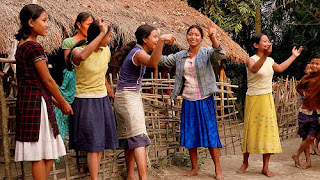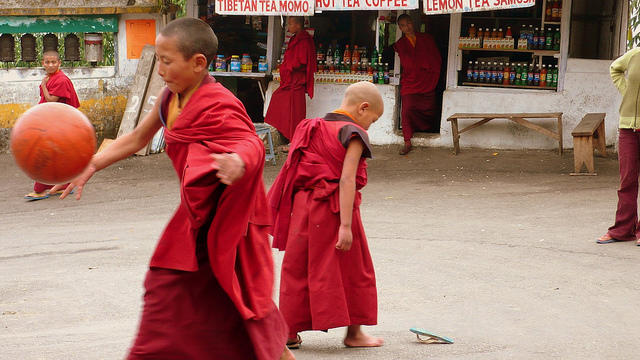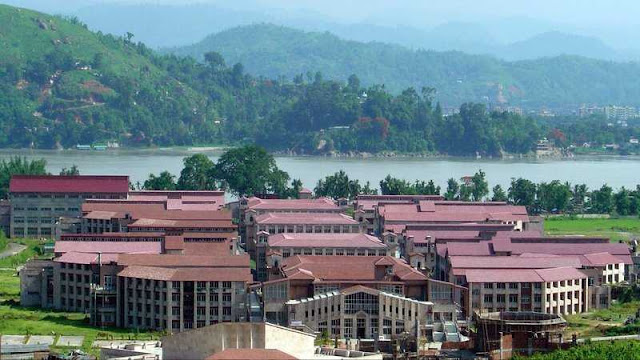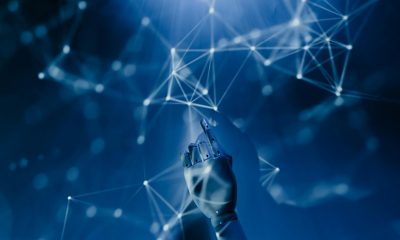North East India
North East India and India’s Look East Policy
 |
| Image by rajkumar1220 |
After the collapse of Soviet Union, India needed a change in its policy. Opening up its market with economic liberalization and globalization, India felt the requirement of securing trade and invite more foreign investments. At that time, South East Asia was experiencing a massive growth and economic development. Countries like Singapore and Malaysia were being recognized as the region with an impressive economic potential.
 |
| Image by rajkumar1220 |
Still not known to many, Myanmar is the second arm of India, like Pakistan is the first arm. In 1947 Pakistan was divided from India, similarly in 1937 Myanmar was divided from British India. Both India and Myanmar share some history which can be explored further to develop better emotional ties.
India
The Political Chaos of Bodoland

Image from BodoEthnicConflict.in
The Dawn, Pakistan’s leading English newspaper tried to give the communal colour to the 23 killings of Muslims last week by National Democratic Front of Bodoland (Songbijit), a militant faction of NDFB under IK Songbijit. But little did it mention about the cause of conflict which is more of Bodo/Non-Bodo centric than religious clashes.
These Bodoland related killings and agitation dates back to Nellie Massacre on February 18, 1983 when 1800 women, men and children belonging to immigrant Bengali speaking Muslim families were killed in just one day during the course of anti-foreigners agitation spearheaded by All Assam Student Union and since then there is a string of killings with Bodo-Muslim clashes of 1993 and 1994 which ended up displacing 2074 families in Kokrajhar and 1,740 families in undivided Bongaigaon, claiming 113 lives. Bodo-Adivasi clashes in May 1996 & 1998 claimed 198 lives displacing 2, 02,684 people triggering the worst ever humanitarian crisis, with some people living as long as 17 years in relief camps.
Karbi-Kuki and Karbi-Dimasa were the other two ethnic clashes in 2005 and 2006 displacing yet another 59000 families in the Karbi-Anglong district. The target has been every community Musilms, Karbi or Adivasis in this land conflict, a movement that was initiated by Upendranath Brahma of All Bodo’s Student Union (ABSU) with its political wing Bodo People’s Action Committee (BPAC) shouting the slogan “Divide Assam 50-50” in 1987 and was assumed to be resolved with the Bodo Accord of 1983
 This demand for Bodoland was not raised for the first time in 1987. The movement has its origins in economic and sociocultural aspirations of Bodo people who first raised a demand for Bodo homeland under British rule but it was not until 1930s that they began to organise themselves. After Nagaland became a state and anticipating further change in the landscape of Assam during the states reorganisation committee under the then Prime Minister Indira Gandhi in 1969, Bodo leadership formed a political party called Plain Tribal Council of Assam (PTCA).
This demand for Bodoland was not raised for the first time in 1987. The movement has its origins in economic and sociocultural aspirations of Bodo people who first raised a demand for Bodo homeland under British rule but it was not until 1930s that they began to organise themselves. After Nagaland became a state and anticipating further change in the landscape of Assam during the states reorganisation committee under the then Prime Minister Indira Gandhi in 1969, Bodo leadership formed a political party called Plain Tribal Council of Assam (PTCA).
The BAC became a failed experiment as the territory of Bodo/Non Bodos was not properly demarcated and there was no political or financial authority provided to this council nullifying the very purpose of economic and sociocultural recognition for Bodos in the Assam land. This lead to resentment among the Bodo groups and this is the point from where Bodo politics started becoming confusing. The ABSU, under its then President Swambla Basumatary rejected the accord reviving its demand for separate state.
During this course of political bargaining PTCA split in 1984 under its militant leader Binai Khunger Basumatary forming a new party United Tribal Nationalists Liberation Front, Assam (UNTLF) and working in tandem with ABSU and both the organizations blaming PTCA for sacrificing interests of tribals.
In the background, a militant outfit known as Boro Security Force (BdSF) (at the time of its inception on October 3, 1896) was planning to take the main stage of Bodo liberation movement and with the weakly coagulated accord of BAC; it saw its chance to coming to forefront and killed Swambla Basumatary. BdSF was known as NDFB after another split group of Bodoland Liberation Tigers (BLT) in 1996.
With the killing of Basumatry, fierce fratricidal clashes followed among the Bodo groups while waging a parallel campaign of statehood with ABSU-led revived movement and BLT killing loyalists of each other.
In the event, the NDFB, which has close but undefined links to the United Liberation Front of Asom (ULFA) and other separatist armed outfits, remained committed to the goal of a ‘sovereign Bodoland’; the BLT, after nearly four years of its own ‘armed struggle’ and a lot of killings, entered into a ceasefire agreement with the AGP government in March 2000, preparatory to peace talks.
Now it was NDFB which had taken the center stage instead of ABSU and PTCA, who were sidelined by second Peace Accord with AGP and then again the series of killings began, the worst being Bodo-Adivasi clashes on 1996 & 1998.
Initially some ABSU leaders started joining BLT when it became a full fledged party but the elections of tribal council brought further discord forming another new party Bodoland People’s Progressive Front (BPPF), which was constituted by ousted ABSU and BLT leaders. The party further split into the BPPF (Hagrama), led by Hagrama Mahilary, the erstwhile BLT chief and chief executive member of the ad hoc BTC, and BPPF (Rabiram), led by Rabiram Narzary, former ABSU president. BPPF (Hagrama) after getting a wide mandate from tribal people in the council election rechristened itself as Bodoland People’s Front (BPF).
Where BPF and BPPF had taken to politics of the state ruling Assembly elections in coalition with Tarun Gogoi’s Ason Gana Parishard (AGP), NDFB kept going with its militant attacks in the state projecting itself as Pro-Bodoland outfit. However in 2008, during the general assembly of the NDFB, its founder chairman Ranjan Daimary was replaced with B.Sungthara. But Daimary claimed the president position of NDFB which resulted in the alleged involvement of Daimary on October 30 serial blasts in which as many as 18 bombs went off in the markets of Guwahati city killing 77 and injuring 470 people. This had split NDFB in further two factions, one led by Daimary known as NDFB (Ceasefire or Progressive) who signed a ceasefire accord with the Gogoi’s government in Assam. But still the faction led by Sungathara which is now NDFB (S) continued its aggression.
Political and militant outfits are splitting into further factions. When government signs an accord with a militant organization, the unsatisfied group in the outfit forms another new outfit again creating the atmosphere of terror strikes and sporadic killings.
The issues of land in India may it be of Telangana, which has recently been declared 29th state of India or of Khalistan movement which want a Sikh dominated region in Punjab or the ones having their demands to divide the state of Uttar Pradesh in parts, are the ones which have taken thousands of lives and have displaced millions of people in this 60 years of independence and all these outfits claiming to be the saviours of the rights of their individual’s community brings destructions to the life of common people, who are already suppressed with their economic and social burdens and in such case these right’s demanding outfit are no better than the one against whom they are fighting for their rights.
These issues need a proper care from the government where it should set state organizations committee and genuinely look to resolve the issues unlike Maoism where even after forming CPI(Maoist), the campaigns like Salwa Judum have occurred, resulting in ever tensing situations and these outfits should also, act as spokesperson of the people whom they are representing, instead of trying to grab the power from the Central or state authorities with terror.
India
North East India: A paradise unexplored or a paradise lost?

Sikkim flickr/ahinsajain
Sikkim and seven sisters of North East India represent seven percent of Indian area and 3.7% of Indian population. These figures hide the immense diversity of languages, ethnicity, culture and biodiversity as well as the wealth of natural resources. Relatively untarnished with human exploitation, unlike most of the India, this place offers a cleaner slate than rest of the country to write a new story of a sustainable development.
The perils on the road to grand promises of this place arise from several unresolved issues of history, the unbalanced component of equation that we have brushed under the rug but not really solved. Depending on what we define as the epicentre of a parochial monolithic identity: Lahore, Delhi, Patna, Thiruvananthapuram or Kolkata, one might find North East India further apart than say Indonesia, which had the same rulers as parts of South India for centuries. North East India and for that matter, several troubled regions of India, can only become full participants to the Indian story and make India a true success story, only when we understand that unlike several more monolithic countries, India had a different history of national evolution. India is not a manifestation of expansion of city-states on ethnic or linguistic lines. It is not a history of one emperor’s sweeping conquests or a legacy of one dynasty. It is a mini world and not just a subcontinent in itself. For Europeans until quite late into Renascences, Hindustan used to be area around Indus and everything to the east of it including South Asia and Parts of South East Asia. In contrast, for majority of Indians (and not all), their country used to be whatever small territories inhabited by people alike them. Even a place hundred miles away could be pardes (foreign country). A lot of South Asia and South East Asia happened to be divided in the current boundaries but could have been divided into several smaller parts or united all as one, if the slight accidents of history were just slightly different. The boundaries are a result of stochasticity and parochialism but not a manifestation of historic inevitability, just as were the establishments of European trading ports and initial colonial conquests in India. It does not mean that there is not a common thread to India or that every inch of its territory is not worth laying one’s life for but what it means is that to unite India, we need to understand its historic and cultural richness. India is much longer and richer experiment of the same kind as is the US: of admixture, conflict and coexistence of different people. Past uncertainties do not mean that we cannot make the future trajectory more certain. To have a future unity and progress we need to understand the past flux and address the unresolved issues. The wounds and the unresolved issues of North East India are a bit more than most of India. These stem from the following:
- Underdevelopment of the border regions, with majority of the agricultural sector being involved in subsistence farming and at times only one highway running through rather large regions.
- Recent demographic shifts add to sources of conflicts. There are several examples of both incidental and state encouraged demographic shifts in the region. The incorporation of Sikkim by India, which was a separate country until 1975, only happened after Nepalese migrants became the majority in the state. In Tripura, influx of Bengali people has rendered the majority Tripuri people to be now just 30% of the population.
- What most Indians forget that India was first populated by groups classified as Austroloid and Mongoloid (the predominant groups in Northeast) by anthropologists and the fact that Chinese population is also genetically a subset of Indian populated that migrated via South East Asia route. North East has interesting history of migration to and back from East and South East Asia. It is ethnically one of the most diverse regions of India. This diversity at times manifests in the form of tribal rivalries. Cultural differences of neighbours can range from nuanced differences to as big of differences as being a patriarchal or a matriarchal society. There are several autonomous state demands in the region that if smartly negotiated and implemented can ease ethnic strife.
- Hypocrisy of Indians claiming Northeast as integral to India when there is trouble with China, while forgetting it at the times of peace. This mistreatment extends to treatment of Northeast people as second grade citizens.
- Heavy handed and indiscriminate response by Indian armed forces and continuation of Armed Forces Special Provisions Act (AFSPA) are sources of ongoing resentment. Northeast has witnessed the only bombing of Indian territory by Indian Air Force. Po Zoramthanga who went on to become the chief minister of Mizoram, once said that the main reason he joined separatist Mizo National Front was because of “Relentless bombing of Aigawi in 1966”. Nagaland has several veteran citizens who claim alive skinning of their comrades in the Naga Nationalist movement by Indian armed forces. International Human Right Watch argues that human rights violations only fuelled insurgency in most states. It is high time to remove AFSPA and punish the rogue elements in the armed forces.
Right now the separatist movements in Northeast have subsided but not died out. Most of them have devolved into criminal nexus that can be dealt with as a law and order problem. This is right time to push the path of development, representation and reconciliation to prevent another wave of separatism. With corridors to both East Asia and South East Asia, we can build several business nodes like Singapore and Hong Kong in the Northeast. This is the right time to put North-East and similarly troubled regions like J&K on the national agenda.
Environment
Impact of IIT Guwahati on India’s North East Region
India’s North East region is one of the most strategically located region in the nation bordered by a number of countries and connected with the rest of the India through a small enclave. The region borders Nepal, Bhutan, China, Myanmar and Bangladesh and is also known as the gateway to East Asia and South East Asia. Its strategic importance is further increased with India’s ‘Look East’ policy. However, the region as a whole has been somewhat neglected by the government and the media.
Trade with the South East Asian countries mainly via sea has seen a rise under India’s renewed policy of better engagement with the eastern nations, but the land connectivity has been ignored which can really help boost the development in north east. Negligence has been observed over all this time for the whole region including the eastern neighbour Myanmar. It is well known that in 1947 India was partitioned forming Pakistan, but very few know the fact that in 1937 Myanmar was divided from British India. Since Independence, India has not shown much interest in its divided arm in the east.
“This is the first article in the series of North East India. We believe North East Region of India is somewhat neglected in the mainstream media, this is an initiative by The World Reporter to bring out the developments, culture, and issues faced by the people here to the rest of India and the world whatever is possible in our capacity. Follow us on Twitter and Facebook to stay connected.“
A more attentive and evaluated approach specially designed for north east is needed for the sustainable development of the region as simply implementing Gujarat or Bihar model will not work for this nature loving and culturally diverse place where each state has its own requirement. One of the biggest step taken by the government is the setting up of the campus of India’s most prestigious research and academic institute of technology, IIT. Indian Institute of Technology, Guwahati, founded in the year 1994, is among the first seven premium IITs which developed with time and established themselves as the seven pearls of India. IITG has been officially recognised as an Institute of National Importance by the government of India.
 |
| IIT Guwahati on the bank of River Brahmaputra |
Unlike other IITs which are situated in the main cities, IITG is located in a remote area which has induced it to become one of the most active IITs to take up sustainable development projects in the greater region surrounding it. From better amenities and lifestyle in the city of Guwahati to improved management of natural resources and renewal energy, various professors and their team are working for preferable infrastructure and lifestyle that would not just help the north east, but whole country in the long term.
Dr. Arup Kumar Sarma of the Dept. of Civil Engg. with his team, in one of his ambitious project, assessed the groundwater fluoride contamination in the city of Guwahati. He took his study forward to study the iron, fluoride, arsenic contamination in the groundwater and its controlling measures in the affected regions of the north eastern states.
Possible groundwater fluoride contamination motivated Dr. A.K Sarma to undertake another project for the utilization of surface water for water supply in Greater Guwahati, this will not only restore the water table, but will also help study the fluoride contamination problem.
Numerous efforts are being made for the better management of north east’s life line, River Brahmaputra and to save the river from human activities. River Brahmaputra is ideally the longest river of India, However, it is known with a different name, Tsangpo, in Tibet making River Ganga the longest river flowing through India. Unlike many rivers in the Indian cities which are dry and dirty, the view of Brahmaputra on the way to IITG coming from the Guwahati city is spectacular with its large volume of water flowing really fast and its massive breadth containing small river islands in it.
Dept. of Civil Engineering of IITG has conducted several hydrographic surveys in the River of Brahmaputra, Ganga, Mekong and their tributaries for various projects like providing measures against flood, draught and river bank erosion.
Soil erosion along the river banks have caused great concerns in the region. According to official estimates from 1954 to 2003, Assam has lost four lakh hectares of land to erosion. Large chunks of land in many tea estates situated near the banks of rivers have been lost because of massive erosion due to the change in course of rivers in the three districts. Another aftermath of soil erosion is the loss in the area of Majuli Island. This island, situated in the River Brahmaputra, is the largest river island in the world which had a total area of 1,250 sq. Km. Now it has significantly come down to mere 421.65 sq. Km, a loss of nearly 66%! Dr. Arup Kumar Sarma’s team is devoted to study the erosion in the Braided Channel of the Majuli Island with a mathematical model.
North East region consists of some of the most difficult terrain, roads and railways are still intact where British engineers had left. Seeing this, north east can take advantage of its high volume rivers for making efficient waterways. IITG’s Civil Engg Dept. feels that North East India’s water resources are underutilized and a number of projects can be taken to provide the local people its benefits efficiently.
 |
| River Brahmaputra, photo by Sagarika Dev Roy |
IIT Guwahati is studying the scope of developing the River System of Brahmaputra as an Efficient Waterway and development of inland water transport in the east and north east India. Another study is examining the scope of linking various rivers and its tributaries in the region for flood mitigation and for efficient use of the fresh water as the river at last goes and merge with the Bay of Bengal Sea making the water unusable for drinking.
There have been growing concerns after an IITG study has found degrading water quality in the tributaries of Brahmaputra-Barak Basin. IITG is developing an environmental management strategy to tackle the issue as early as possible.
In more such research projects, IITG is studying the scope and constraints of reservoir project in North East India. In 2004, IITG team lead by Dr. A. K. Sarma conducted field investigation for developing a Detailed Project Report for a mini hydroelectric project in a remote area of Manipur.
A study conducted by IIT Guwahati on the impact of climate change on the water resources of the Brahmaputra basin brought to the light that there would be symbolic changes in rainfall pattern and temperature in the future. “High intensity rainfall of shorter duration and longer dry spells will affect the flood and drought scenario,” said, The chairman of the North Eastern Tea Association (NETA), Bidyananda Barkakoty. This will cause significant damage to the tea crops in Assam and north east which is the most famous black tea in the world. Growing concerns in the tea industries, in 2011, tea gardens in Golaghat, Karbi Anglong and Jorhat districts approached IITG for developing rainwater harvesting infrastructure for better nurturing of tea crops tackling climate changes.
In the area of sustainable development, quality of lifestyle and natural resources a lot of attempts and achievements have been made by the IITG, but that is not where its role ends. IITG has also taken up the challenge of refining and nurturing the most promising resource, the human resource.
No doubt every year IITG produces first class international standard science and engineering graduates, IITG has also dived into giving short term management and training courses for local students with Indian Institute of Management Shillong. IIM Shillong was the earliest addition to the well-known already established six IIMs across India. Thus, North East region received again the seventh campus of most prestigious management institute of India, IIM. IIT-G and IIM-S together will be providing courses encompassing subjects like management, entrepreneurship, tourism and hospitality with an attempt to stop the emigration of youngsters from the North-East to other parts of India, while also helping them refine their skills for better employment opportunities.
In a similar program with a motive of creating entrepreneurs in north east IITG has setup Entrepreneurial Development Cell (EDC) which is a special interest group under Technical Board of the Students Gymkhana Council responsible for activities and initiatives to promote the spirit of entrepreneurship amongst the IITG community as well as the youth of North-East India. The EDC organizes lectures, events and workshops to create a platform for students to realize their entrepreneur potential. Such a program will help develop businesses and create more jobs in the region helping prevent the exodus of youngsters from North East to other parts of India.
In a society where to most of us development means construction of malls, high rise residential buildings and hi-tech office complexes, in North East, IITG has made sure that every development benefits every class of the society without disturbing the nature, which is most revered by all of us.
-

 Business12 months ago
Business12 months agoHow To Future-Proof Your Business With The Right Tools
-

 Travel10 months ago
Travel10 months agoTravelling from San Antonio to Guadalajara
-

 Travel7 months ago
Travel7 months agoTravel wellness tips for a healthier and more enjoyable journey
-

 Europe5 months ago
Europe5 months agoRecent Books by Boaventura de Sousa Santos: Law, Colonialism, and the Future of Europe




